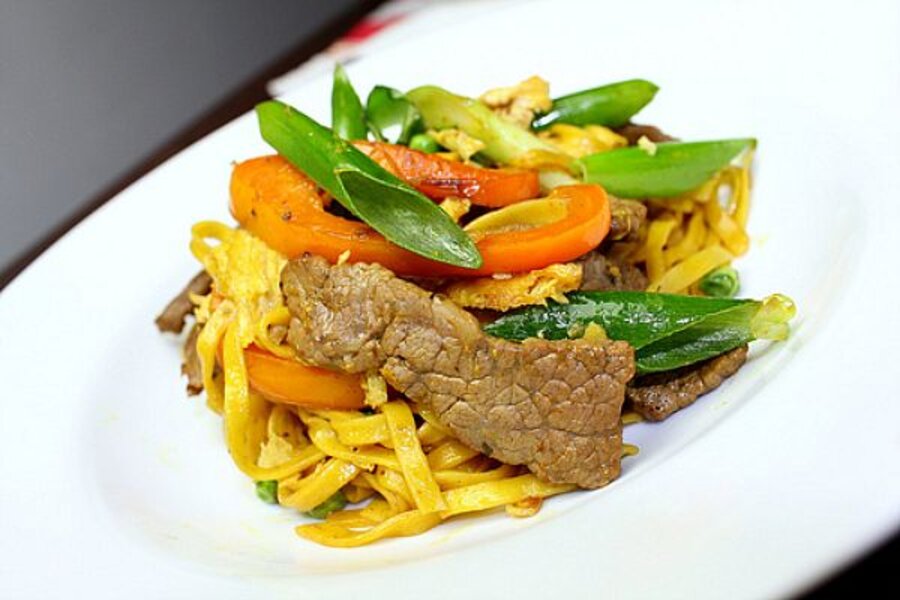Guyanese chow mein
Loading...
Guyana, sitting on the top right of the land mass of South America, is among the least known and most mysterious of that continent’s countries, something that is almost as true today as it was when Sir Arthur Conan Doyle used it as the setting for his 1904 novel, "The Lost World." Home to the most intact and least spoiled rain forests in South America, Guyana’s biodiversity is simultaneously staggering and largely undocumented, and cascading from its mossy, permanently cloud-topped peaks, fall several of the world’s largest waterfalls. Guyana is also unique on a human-scale, having the distinction of being the only English-speaking nation in South America, and, perhaps because of this, of having been among the world’s largest producers of natural latex for the manufacture of cricket balls
The cricket-loving population is a heterogeneous mix of Indian, African, European and native peoples, roughly in that order of volume. However, like much of the English-speaking Caribbean, Guyana also has a tiny, but significant, Cantonese population – a legacy of the same forces at work during the days of the British Empire that also relocated large numbers of Tamil and Gujurati Indians there to work as indentured plantation workers. Numerically insignificant, the lasting impact of these Hong Kong Chinese has been on local commerce and the cementing of certain southern Chinese dishes, the most popular of which is chow mein, in the diverse local cuisine.
Of course, the chow mein enjoyed in Guyana bears only a certain resemblance to that eaten in Canton and other parts of China, I am sure. Indeed, Chinese food all over the western world has been amended to suit local tastes and ingredients, and so it is in Guyana where access to even basic Chinese staples like soy sauce was not always possible. Similarly, the inevitable mixing between local gastronomic cultures, namely the addition of a sly pinch of West Indian curry powder that seems to find its way into all kinds of unlikely dishes across the Caribbean, is what makes this chow mein recipe inherently Guyanese, not to mention the bright yellow noodles, made with soft wheat and plenty of food coloring. Other local variations on the original include the addition of yellow squash and green beans.
We had never eaten this dish before, but we’d experienced it up-close at several West Indian parades both in New York City and London, where it was served in trays with plastic forks as street food, and where the searing perfume of garlic and curry managed to cut right through the ripe fragrance of perspiring dancers. In truth, the flavors, with the combination of curry and soy sauce, aren’t that dissimilar to the popular Singapore noodles found throughout South-East Asia and at many British Chinese restaurants, and they should feel relatively familiar to anyone who has eaten both Chinese and Indian take-out food before. So, while you (or we) may never get to visit exotic Guyana and witness first hand either it’s beautiful landscape or delicious cuisine, you should try making this dish. It only takes about 20 minutes to prepare and will satisfy a host of your ethnic food cravings.
(See next page for Guyanese Chow Mein recipe)
Guyanese Chow Mein
Serves 3-4
1 x 12-ounce package of Guyanese chow mein noodles
1/2 lb. thinly sliced beef, chicken or whole medium shrimp
3 cloves garlic, finely sliced
1/2 onion sliced thinly
1/2 sweet bell pepper, sliced
1 hot pepper, warri-warri or similar medium-hot type, seeds removed, finely diced
1/2 teaspoon Caribbean curry powder (not strictly traditional, but a delicious addition)
2 tablespoons dark soy sauce
2 eggs, whisked
2-3 spring onions (eschallots), cut into 1 inch batons
(optional, but traditional) butternut or other firm bright fleshed squash
(optional, but traditional) green peas or long beans
2 tablespoons peanut or vegetable oil
1 tablespoon water mixed with 1/2 teaspoon corn starch
Boil noodles in abundant salted water for 6 minutes or until fully cooked
Heat wok to high, add half oil and cook whisked eggs, chopping them with spatula until fully cooked
Remove from wok and reserve.
Add remaining oil, and after 5 seconds, add bell peppers.
Cook on high heat stirring regularly for 2 minutes until they start to wilt a little.
Add onions, garlic and hot pepper and cook for another minute before adding meat/poultry/shrimp
Cook meat until done before adding soy sauce, sprinkling on curry powder and 1 tablespoon of water mixed with corn starch.
Stir well before quickly adding reserved noodles, peas and spring onions.
Continue to stir until all noodles are well coated with sauce.
Serve immediately.
Jonny and Amy Seponara-Sills blogs at We Are Never Full.
To comment on the original post, click here.
--------------------------------------------------------------
The Christian Science Monitor has assembled a diverse group of food bloggers. Our guest bloggers are not employed or directed by The Monitor and the views expressed are the bloggers' own and they are responsible for the content of their blogs and their recipes. All readers are free to make ingredient substitutions to satisfy their dietary preferences, including not using wine (or substituting cooking wine) when a recipe calls for it. To contact us about a blogger, click here.





